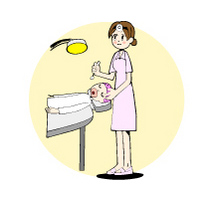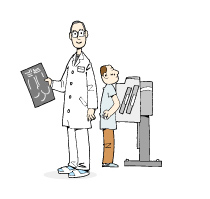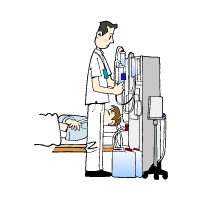活発化する日本の活火山-Volcanic activity in Japan has been activated-【環境】

110の活火山のうち47が監視対象に
鹿児島県口永良部島の新岳が5月29日、爆発的噴火を起こして全島民が島外に避難しました。神奈川県の箱根山では火山性地震が頻発し、気象庁は5月6日に火口周辺に影響を及ぼす噴火の可能性があるとして噴火警戒レベル2、6月30日からは入山規制にあたるレベル3を発表しました。また、昨年9月の御嶽山の噴火では、登山者など多数の人が犠牲になりました。
日本には現在110もの活火山があり、47の火山については24時間体制で監視が続けられ、31の火山には噴火警戒レベルが設定されています。日本は火山・地震列島とも呼ばれています。日本の地理的状況を十分に理解し、火山噴火や地震などの自然災害に備えたいものです。(8月10日に作成)
Of the 110 active volcanoes, 47 are under monitoring
Mount Shindake on Kuchinoerabu Island in Kagoshima Prefecture caused an explosive eruption on May 29, and all islanders evacuated outside the island. On May 6, the Japan Meteorological Agency issued a Level 2 warning for volcanic activity at Mount Hakone in Kanagawa Prefecture. It raised the volcanic eruption warning to Level 3 on June 30. Mount Ontake erupted and killed many people last September.
There are 110 active volcanoes in Japan and 47 of them are constantly monitored 24 hours a day. Japan is known as "Volcano islands" and "Earthquake-prone archipelago." We should understand geographic features of Japan and prepare for natural disasters such as volcanic eruptions and earthquakes.
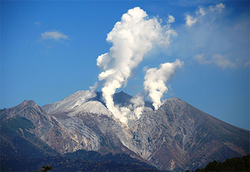 - 「活火山」の定義の変遷 -
- 「活火山」の定義の変遷 -かつて、火山は「活火山」「休火山」「死火山」と分類されていました。つまり、御嶽山や新岳、箱根山など現在活動中の火山を「活火山」、富士山など過去に噴火記録が残っているものの現在活動を休止している火山を「休火山」、そして有史以来噴火の記録がない火山を「死火山」と呼んでいました。
しかし、火山活動の寿命は長く、数百から数千年という非常に長い期間を経て活動を再開した火山もあります。このため、国際的に過去1万年間の噴火履歴で活火山と定義するという考え方が一般的となってきました。
日本でも1975年に、火山噴火予知連絡会が「噴火の記録がある火山及び現在活発な噴気活動のある火山」を活火山と定義し、77の火山を活火山に選定しました。その後、火山学の発展に伴って噴出物の調査などから噴火の証拠が新たに発見され、活火山の数は増えていきました。こうした過程で休火山や死火山といった表現は消えていきました。
そして2003年、「概ね過去1万年以内に噴火した火山及び現在活発な噴気活動のある火山」と定義し直し、現在の日本の活火山の数は110となっています。
- Change of the definition of "active volcano" -
In the past, volcanoes were classified as "active volcano", "dormant volcano" and "extinct volcano." An active volcano is a volcano that is currently erupting or has erupted recently, such as Mount Ontake, Mount Shindake and Mount Hakone. A dormant volcano is one that has not shown eruptive activity within recorded history, such as Mount Fuji. An extinct volcano is one that has not shown any historic activity.
Volcano lifetime is long, and some volcanoes become active again after hundreds or thousands of years. It became accepted internationally to define active volcanoes as volcanoes which have erupted within the past 10,000 years.
The Coordinating Committee for Prediction of Volcanic Eruptions defined active volcanoes as "those that have a history of eruption and those that are showing signs of fumarolic activity, which means a vent on the mountain is spewing steam and gases." The committee designated 77 volcanoes in Japan as active using this definition. Advances in volcanology have unearthed new evidence of the past. The number of active volcanoes has increased.
In 2003, CCPVE changed the definition of active volcano to "volcanoes which have erupted within approximately the last 10,000 years, or which currently show fumarolic activity." With this definition, the number of active volcanoes in Japan are 110.
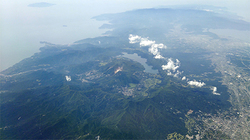 - 火山噴火の仕組み -
- 火山噴火の仕組み -地球は中心から核(内核、外殻)、マントル(下部マントル、上部マントル)、地殻で構成されています。地殻と上部マントルの間は、プレートと呼ばれる厚さ100㎞程の硬い板状の岩盤となっています。地球は十数枚のプレートで覆われ、地球内部で対流しているマントルの上に乗っているためプレートは少しずつ移動しています。
火山ができるところは、日本列島のように海洋プレートが沈み込むところや、プレートの裂け目から溶けたマントルが湧き出す海嶺、それにハワイ諸島のようにマントルの深い部分の熱源からマントルが湧き上がるホットスポットの3つがあります。
海洋プレートの沈み込みによる火山活動では、海側のプレートが陸側のプレートの下に沈み込む時、絞り出される水の働きによってマントルの一部が溶けてマグマを形成し、マグマ溜まりに蓄えられます。何らかの作用を受け、マグマ溜りからマグマが上昇すると全体の圧力が下がり、高温高圧下で溶けていたガスが気体となって体積を増し、地表に出ようとする力が働きます。地表近くになると、こうした現象は加速度的に進み、一気に火道を上昇して火口を開いて噴火するのです。
噴火には、マグマの熱で地下水が気化して圧力が上昇することで起こる「水蒸気噴火」、マグマが直接地下水や海水に接触して起こる「マグマ水蒸気噴火」、マグマが火口から噴出して溶岩流や火砕流を引き起こす「マグマ噴火」があります。
- The mechanism of volcanic eruptions -
The Earth has a core (inner core, outer core) surrounded by a mantle (lower mantle, upper mantle), and that is surrounded by crust. The plates are made up of Earth's crust and the upper part of the mantle layer underneath. The plates are 100km thick. Dozens of plates cover Earth's surface, and the convection currents below in the mantle move these plates around on the surface of the Earth. The Earth is made up of roughly a dozen major plates.
There are three places where volcanoes form: subduction zones, an oceanic plate is forced beneath another plate, such as Japanese archipelago; mid-ocean ridges, new magma constantly emerging onto the ocean floor and into the crust at and near rifts along the ridge axes; hot spots, areas of volcanic activity that form from plumes of hot, solid material that have risen from deep within Earth’s mantle, such as Hawaiian Islands.
Subduction zone volcanism occurs where two plates are converging on one another. Magma generation is the consequence of the interaction between fluids. Stratification of a magma chamber results in an increase in the amount of gas within the magma, and causes the pressure in the chamber to increase. That pressure can gradually fracture the rock around it creating outlets for the magma. If it finds a way to the surface, then the result will be a volcanic eruption. It leads to an eruption.
There are three different types of eruptions: "phreatic eruptions", which is driven by the superheating of steam via contact with magma ; "phreatomagmatic eruptions", that are driven by the direct interaction between magma and external bodies of water such as the sea or groundwater ; "magmatic eruptions", when magma is ejected from the surface, it releases a torrent of lava and pyroclastic flows.
- 47火山は24時間体制で監視・観測 -
日本列島はユーラシアプレート、北米プレートという2つの大陸プレートの上にあり、太平洋プレートとフィリピン海プレートという2つの海洋プレートが日本列島の下に沈み込んでいます。このため、日本列島は世界でも有数の火山地帯であり、いつ爆発的噴火が起こっても不思議ではありません。
火山噴火予知連絡会は2009年、「火山防災のために監視・観測体制の充実等の必要がある火山」として47火山を選定しました。これらの火山には、噴火の前兆を捉えるために地震計、傾斜計、空振計、GPS観測装置、望遠カメラなどの観測施設を整備し、24時間体制で常時観測・監視しています。観測体制を充実させ、火山噴火の予知に役立てようというものです。
しかし、火山にはそれぞれ個性があり、噴火の前兆も異なるため、予知には長期間にわたる幅広いデータの蓄積が必要とされます。このため、まだはっきりとした予測が出来ないのが現状です。
- 47 volcanoes are constantly monitored 24 hours a day -
The Japanese Islands are in marginal areas of the Eurasian Plate, the North American Plate, the Pacific Plate, and the Philippine Sea Plate. As the Japanese archipelago lies in the volcano and earthquake belt, eruption is going to happen anytime.
In 2009, the Coordinating Committee for Prediction of Volcanic Eruptions investigated the volcanoes in Japan and listed 47 volcanoes as those to be intensively monitored for the time being. These volcanoes are constantly observed and monitored 24 hours a day using seismograph, inclinometer, infrasound meter, GPS observation equipment and the telecamera to capture the sign of the eruption.
It is very difficult to predict volcanic eruptions. Each volcano is unique, and the sign leading to the eruption of one volcano may be completely different than other cases. It is necessary to accumulate a wide range of data to predict them.
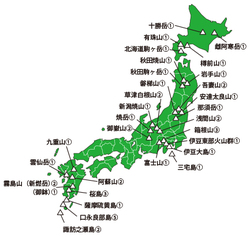 - 噴火警戒レベルが設定された火山 -
- 噴火警戒レベルが設定された火山 -47火山のうち、さらに31の火山について2007年から気象庁が5段階の噴火警戒レベルを設定しています。噴火警戒レベルとは、気象庁が周辺住民や登山者に向けて火山活動の状況を示す指標です。危険が及ぶ範囲や必要な防災対策に応じて、レベル1(活火山であることに留意)、レベル2(火口周辺規制)、レベル3(入山規制)、レベル4(避難準備)、レベル5(避難)の5段階で警戒を呼びかけています。
5月に噴火した口永良部島では7月7日現在、全島民が避難しているためレベル5、箱根山や桜島はレベル3で入山規制されています。草津白根山、吾妻山、浅間山、御嶽山、阿蘇山、霧島山、諏訪之瀬島はレベル2で、他の火山はレベル1となっています。
- Volcanic Alert Levels for Volcanoes -
Japan Meteorological Agency has set the eruption threat level of five stages to 31 volcanoes out of 47 volcanoes since 2007. The Volcano Alert Levels are intended to inform peripheral residents and climbers about a volcano's status. 5 volcano alert levels are assigned according to the status of volcano activity, each clearly connected to a specific set of disaster countermeasures: Level 1, Be mindful that the volcano is potentially active; Level 2, Do not approach the crater; Level 3, Do not approach the volcano; Level 4, Prepare to Evacuate; Level 5, Evacuate.
All Residents evacuated Kuchinoerabu Island and the volcanic alert level 5 was issued, then a level 3 alert has been issued for Mount Hakone and Sakurajima as of July 7. As for the volcanic activity in Mount Kusatsu-Shirane , Mount Azuma , Mount asama, Mount Aso, Mount Kirishima and Suwanose Island, volcanic alert level 2 was issued and other 21 volcanoes, level 1 was issued
- 火山噴火と地震の関係 -
2011年3月の東日本大震災以降、東日本を中心に余震とみられる地震が頻発し、噴火も目立つようになりました。
研究者の間では、巨大地震が火山噴火を誘発しているのではないかと指摘する声が聞かれます。地震によって地下の歪みが増大してマグマが絞り出され易くなっていることや、振動でマグマ溜りが揺さぶられ、マグマが一気に発泡して爆発的噴火に繋がっているのではというものです。実際、過去に巨大地震によって火山噴火を誘発してきた事例が数多くあります。
私たち日本人は過去の経験を踏まえ、いつ襲ってくるかも知れない自然災害に備えなければなりません。
- A connection between volcanic eruptions and earthquakes -
Aftershocks have occurred frequently since the Great East Japan Earthquake in March 2011, and eruptions have become noticeable.
Some seismologists have pointed out that large earthquakes may trigger volcanic eruptions. Large earthquakes passing through a magma reservoir may cause the nucleation of bubbles within the magma. These events could prompt an eruption. Actually, some volcanic eruptions were caused by large earthquakes in the past.
We Japanese must always provide against disasters, reflecting on the past experience.





